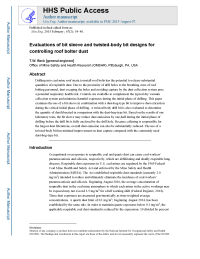Mining Publication: Evaluations of Bit Sleeve and Twisted-Body Bit Designs for Controlling Roof Bolter Dust
Original creation date: February 2015
Drilling into coal mine roof strata to install roof bolts has the potential to release substantial quantities of respirable dust. Due to the proximity of drill holes to the breathing zone of roof bolting personnel, dust escaping the holes and avoiding capture by the dust collection system pose a potential respiratory health risk. Controls are available to complement the typical dry vacuum collection system and minimize harmful exposures during the initial phase of drilling. This paper examines the use of a bit sleeve in combination with a dusthog-type bit to improve dust extraction during the critical initial phase of drilling. A twisted-body drill bit is also evaluated to determine the quantity of dust liberated in comparison with the dust-hog-type bit. Based on the results of our laboratory tests, the bit sleeve may reduce dust emissions by one-half during the initial phase of drilling before the drill bit is fully enclosed by the drill hole. Because collaring is responsible for the largest dust liberations, overall dust emission can also be substantially reduced. The use of a twisted-body bit has minimal improvement on dust capture compared with the commonly used dusthog-type bit.
Authors: TW Beck
Peer Reviewed Journal Article - February 2015
NIOSHTIC2 Number: 20046539
Min Eng 2015 Feb; 67(2):34-40
See Also
- An Approach to Identifying Geological Properties from Roof Bolter Drilling Parameters
- Best Practices for Controlling Respirable Dust in Coal Mines
- Cableless Electronic Surveying Systems for Horizontal Holes
- An Evaluation of Methods for Controlling Silica Dust Exposures on Roof Bolters
- Noise Exposure and Overhead Power Line (OPL) Safety Hazards at Surface Drilling Sites
- Roof Screening: Best Practices and Roof Bolting Machines
- Sound Power Level Study of a Roof Bolter
- Status of a Tapered Element, Oscillation Microbalance-Based Continuous Respirable Coal Mine Dust Monitor
- Summary of NIOSH Research Completed on Dust Control Methods for the Surface and Underground Drilling
- Workplace Solutions: Reducing Hazardous Dust Exposure When Rock Drilling During Construction
- Content source: National Institute for Occupational Safety and Health, Mining Program


 ShareCompartir
ShareCompartir
